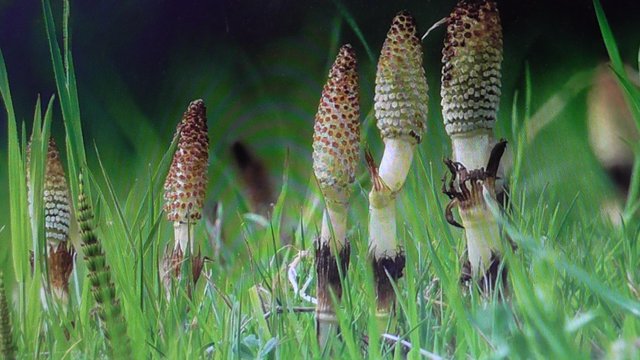Survival Food Nr.14 Schachtelhalm ! Survival Food No.14 Horsetail!
Hallo liebe steemians ,
Hier stelle ich euch das "Zinnkraut" oder den
Schachtelhalm vor . "Zinnkraut" deswegen ,
weil im Mittelalter damit das Zinngeschirr
gereinigt wurde . Gesammelt wird Ackerschachtelhalm
im Frühjahr und im Sommer bis zum Juli. Also es wird Zeit.
Man muss aufpassen den Acker - nicht mit dem giftigen
Sumpfschachtelhalm zu verwechseln . Mit ein bisschen
Übung kriegt man das allerdings leicht hin . Als erstes ist da der
Standort , der Sumpfschachtelhalm auf sumpfigen Gelände ,
Bachläufen und Mooren . Der Ackerschachtelhalm auf
Äckern und Feldwegen . Der Ackerschachtelhalm hat
dickere Stängel , sie sind breiter als drei Millimeter , während die
Stiele des Sumpfschachtelhalms deutlich schmaler sind .
Zum Schluss noch kleiner Trick zur Unterscheidung .
Drücke einen Stängel zusammen , reisse ihn am ersten
Halmansatz (Schachtel) ab . Kommt ein feiner Haarpinsel
oder -besen (Eselsbrücke = Besen , sauber , gut.)
Bleibt der mittlere Stiel länger wie eine Lanze (Eselsbrücke =
Lanze gefährlich nicht gut.)
Hello dear steemians,
Here I introduce you the "horsetail" or the
Horsetail in front. "Horsetail" because of that,
because in the Middle Ages so the pewter dishes
was cleaned. Collected field horsetail
in spring and in summer until July. So it's time.
You have to watch the field - not the poisonous one
Muck horsetail to be confused. With a little bit
But you can easily get that exercise. First, there is the
Location, the marsh horsetail on swampy terrain,
Streams and bogs. The field horsetail on
Fields and dirt roads. The field horsetail has
thicker stems, they are wider than three millimeters, while the
Stems of the marsh horsetail are much narrower.
Finally, a little trick to distinguish.
Press a stem together, tear it at the first
Halmansatz (box) from. Come a fine hairbrush
or broom (donkey bridge = broom, clean, good.)
If the middle stem stays longer than a lance (donkey bridge =
Lance dangerous not good.)
Aufgrund seiner Bitterstoffe und (Saponine ,gutes
Waschmittel) sollte der Surviver die gesammelten
Teile ca 8 Stunden in fließendes Wasser hängen .
Danach kann man sie in Suppen , Salate und Eintöpfe
geben . Jetzt ist es höchste Zeit , bevor sie holzig werden .
Due to its bitter substances and (saponins, good detergent)
The Surviver should collect the collected parts for about 8 hours
hanging in running water. After that you can put them in
Give soups, salads and stews. Now it is the highest
Time before they get woody.
Zum Trost kann man aber die stärkehaltigen
Wurzelknöllchen das ganze Jahr über gebrauchen .
Sie können wie Kartöffel(chen) gekocht werden und
in den Survivaleintopf gegeben werden .
As a consolation you can but the starchy Use root nodules
all year round. They can be cooked like potato (ses) and be
placed in the survival stew.
Ich wünsche viel Spass beim sammeln , bestimmen
und verwerten . unsuwe



Congratulations @unsuwe! You have completed the following achievement on Steemit and have been rewarded with new badge(s) :
Click on the badge to view your Board of Honor.
If you no longer want to receive notifications, reply to this comment with the word
STOPTo support your work, I also upvoted your post!